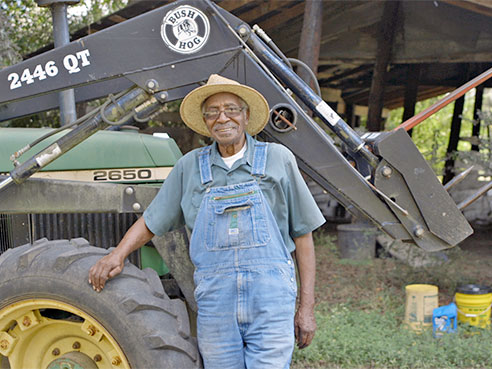Earnest Tate is no stranger to adversity or history. When he was named the first black police chief of Selma in the late 1990s, he had to lead and unify a police force that had been heavily scrutinized during the civil rights era.
“My goal was to make it the best police department in the state of Alabama, and I did that,” Tate said.
Nearly 20 years later, Tate is now retired and works on his family farm in the city where he made history. But a minor heart attack that led to heart failure threatened his ability to work the land he loves so dearly.
“I tried to not show sickness; but since my wife was a nurse, she still saw it,” Tate said. “It made a big impact on my whole family. I never got scared because I never had time to get scared.”
Tate recalled that it was hard to breathe while standing up. He says it would take him a long time to walk from the bedroom to the kitchen.
After consulting with his primary care physician in Selma, Tate was sent to UAB for a consultation. It was there that he met James Davies, M.D., and Oluseun Alli, M.D., and learned he had a condition called aortic stenosis.
Aortic stenosis occurs when the heart’s aortic valve narrows, preventing the valve from opening fully.
Mark F. Sasse, M.D., an associate professor of interventional cardiology, says Tate’s heart pumping function was significantly reduced compared to normal.
 Tate’s heart pumping function was significantly reduced, but thanks to transcatheter aortic valve replacement (TAVR) Tate can now get back to what he loves doing most — working on his farm."“The pumping function of Mr. Tate’s heart was fairly reduced, so he was at a higher risk than our normal transcatheter patients,” Sasse said. “The percentage of blood being pumped out was nearly 30 percent less than in people with normal pumping function.”
Tate’s heart pumping function was significantly reduced, but thanks to transcatheter aortic valve replacement (TAVR) Tate can now get back to what he loves doing most — working on his farm."“The pumping function of Mr. Tate’s heart was fairly reduced, so he was at a higher risk than our normal transcatheter patients,” Sasse said. “The percentage of blood being pumped out was nearly 30 percent less than in people with normal pumping function.”
The structural heart team of Davies, Alli and Sasse determined that Tate was a prime candidate for transcatheter aortic valve replacement.
Sasse says transcatheter aortic valve replacement, or TAVR, provides easier recovery compared to open-heart surgery as patients typically do not stay in intensive care as long.
In the TAVR procedure, a replacement valve is placed inside a catheter. The catheter is then threaded through blood vessels in the leg or through the chest of the patient. The valve is then positioned into the old valve while the heart is still beating. The heart is able to pump blood through the replacement valve normally.
After the TAVR device was successfully placed, Tate said he felt physically better soon after the procedure was complete. Sasse is happy to see that his patient is doing well and ready to get back to a normal life.
“We took a person who was very debilitated and gave him back his life,” Sasse said. “He couldn’t sleep at night. Now he can sleep. People who can’t do daily activities are able to do those things now. That’s the real benefit of this procedure.”
After visiting with Sasse for a one-month checkup, Tate is now feeling better and is able to do the things he wants to do without feeling tired.
“I can rest better at night,” Tate said. “I used to be too tired to eat. My appetite came back. I used to have to ride in a wheelchair, but I don’t have to ride in a wheelchair anymore.”
| UAB was the first hospital in the state of Alabama to perform the TAVR procedure, in 2012. More than 300 total cases have been completed since then. |
UAB was the first hospital in the state of Alabama to perform the TAVR procedure, in 2012. More than 300 total cases have been completed since then. Sasse says his staff averages four or five per week.
“With people who had been considered for open-heart surgery in the past, we’ve noticed certain subgroups, typically the elderly, don’t do well,” Sasse said. “All these patients were offered high-risk surgeries or nothing at all. TAVR gave them another option.”
The sky is the limit for people with heart failure, according to Sasse. UAB is already in its third iteration of the valve with the Sapien-3 valve.
“The engineering keeps getting better each time,” he said. “The companies are still working on making them better. The future is bright for treating a bigger patient population.”
That is good news for patients like Tate. Now 80 years old, Tate is back happily calling his cows and tending to his farm, and feels he has plenty ahead of him.
“It was a relief to go home,” Tate said. “It took me several months to get sick, and I know it is going to take several months to get well. I believe now I can live to get 100 years old. It’s what I feel.”
| Several patients share their stories of how UAB’s heart team helped them overcome serious valve disease problems that could otherwise have shortened their lives. |